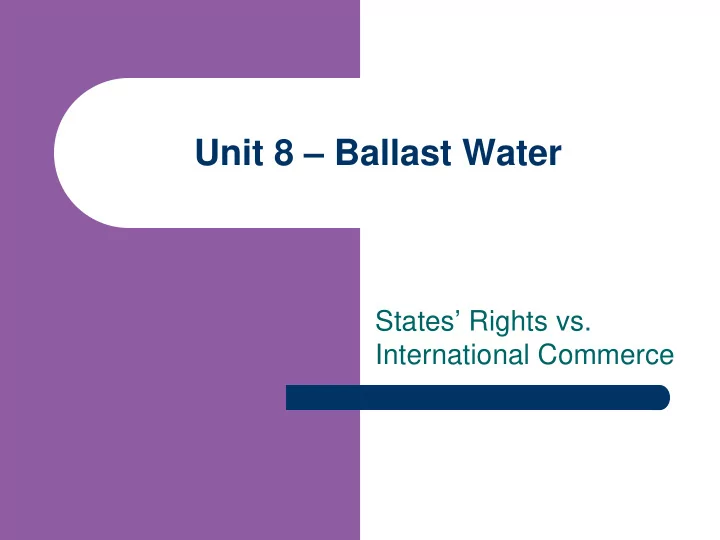

Unit 8 – Ballast Water States’ Rights vs. International Commerce
The Ballast Water Problem Cross section of ship showing ballast tanks and ballast water cycle Graphic Credit IMO
Ballast Water Exchange � Replace lower-salinity coastal water with higher-salinity open-ocean water between ports of call. � Reduces the number of potentially invasive species in the ballast tanks Ship exchanging BW
Ballast Water Treatment � Mechanical – Filtration and separation � Physical - Sterilization by ultraviolet light, ozone, heat, electric current, or ultrasound � Chemical – Biocides � Drawbacks: – Costly – Retrofits Required – Additional Training
International Convention for the Control and Management of Ships’ Ballast Water and Sediments � Adopted on February 13, 2004 under the auspices of the IMO. � Will enter into force 12 months after ratification by 30 nations, representing 35% of the world merchant shipping tonnage. – As of March 31, 2007, 8 signatories representing 3.21% of tonnage.
Federal Regulation � Nonindigenous Aquatic Nuisance Prevention and Control Act of 1990 passed in response to zebra mussel invasion. (Reauthorized by NISA) – Authorized issuance of regulations “to prevent the introduction and spread of aquatic nuisance species into the Great Lakes through the ballast water of vessels.” – Authority delegated to Coast Guard � Clean Water Act (EPA)
Coast Guard BWM Program � Vessels carrying ballast water and operating in the Great Lakes or on the Hudson River must employ one of the following: – Open-ocean ballast water exchange; – Retain ballast water on board; or – Use an alternative environmentally sound method of BWM approved by the Coast Guard.
NOBOBs – Loophole? � Ballast water reporting forms � Voluntary best management practices – Mid-ocean exchange – Saltwater flushing of empty tanks
Clean Water Act � Illegal to discharge pollutants from a point source into the navigable waters of the U.S. without a National Pollutant Discharge Elimination System (NPDES) permit. – Discharges “incidental to the normal operation of a vessel” exempt from NPDES program. � In 2005, California district court ordered EPA to repeal exemption and regulate BW.
Michigan BWM Program � Senate Bill 332 – All ocean-going vessels engaging in port operations in Michigan after January 1, 2007 must obtain a permit from the MDEQ. � Ballast Water Control General Permit – Four treatment methods identified: (1) hypochlorite; (2) chlorine dioxide; (3) ultraviolet (UV) light radiation; and (4) deoxygenation.
Shipping Company Challenge � In March 2007, several international shipping companies filed suit challenging Michigan’s program. – Argue that the law is preempted by federal regulation and violates the Commerce Clause. � Congressional Action?
Recommend
More recommend